By Sean Trende
The consensus (more or less) among political analysts was that the
GOP was likely to lose in the shutdown showdown, but was unlikely to
suffer serious electoral consequences. The first prediction appears to
be the case (but see Peter Beinart's smart contrarian take). How about the second one?
It is early, but what evidence we have seems consistent with the idea
that the GOP didn’t take on much electoral water from this loss. This
isn’t to say that there isn’t any evidence that the shutdown hurt Republicans, but the idea that their prospects were seriously jeopardized is thin.
Start with Wednesday night’s Senate election in New Jersey. Democrat
Cory Booker defeated Republican Steve Lonegan by just over 10 points,
54.6 percent to 44.3 percent. This result is right in the middle of
previous Republican gubernatorial and Senate performances in the state
(gubernatorial races are in odd years; Senate races are typically in
even years):
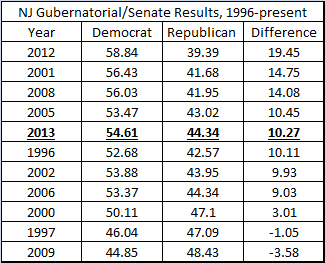
In fact, the result was closer to John Kerry’s 2004 victory margin
(6.7 points) than to Barack Obama’s 2012 margin (17.8 points).
To be clear, this was an off-year special election held on a
Wednesday. We’d probably expect a drop-off in Democratic performance
given this, especially from Obama’s numbers.
But Lonegan was a problematic candidate: a “true conservative”
running unabashedly as such. Booker has been tagged a rising Democratic
superstar, who also should have theoretically benefited from his status
as mayor of the state’s largest city. Indeed, Essex County was one of
three counties where Booker ran roughly even with the president (Bergen
and Hudson, also in northern New Jersey, are the other two).
This isn’t a bad showing for a Democrat. It’s about what you would
expect in neutral circumstances in the state. But that’s just the point:
If the bottom were dropping out for Republicans, we’d expect this race
to look more like the 2008 or 2012 Senate races.
Let’s also look at what is the most important electoral predictor for
midterm elections: presidential job approval. There’s something of a
mixed bag here. These are the polls in the RCP Average for job approval that also surveyed the public in the month before the shutdown began:
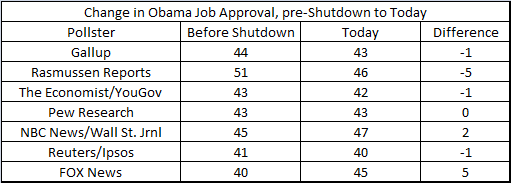
The evidence here isn’t consistent with a big surge for the
Democrats. Fox News shows a relatively large spike in Obama’s approval,
while Rasmussen Reports shows a relatively large drop-off. Everything
else has remained roughly the same. Obama is still nowhere near the type
of job approval numbers that he’ll probably need before we can start
talking seriously about Democrats taking back the House.
But isn’t the Republican brand so far in the tank that it doesn’t
matter? There’s no doubt that it took a hit. But let’s look a bit closer
at the Pew poll, and compare its various measurements to polls taken
just before elections in other years. Here are the job approval numbers:
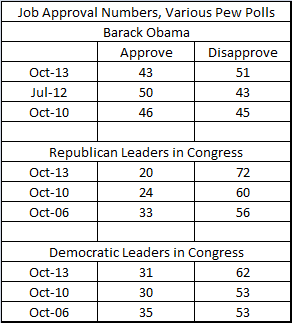
Now, people don’t like Republican congressional leaders much, but
their numbers are comparable to where they were in 2010, a Republican
wave year. The same is true of Democrats, though their numbers are also
comparable to 2006, a Democratic wave year. This is consistent with what
I mentioned above: It is presidential numbers that matter most. The
president’s numbers are below what they were in 2010 (which is also true
of the RCP Average).
What about the generic ballot?
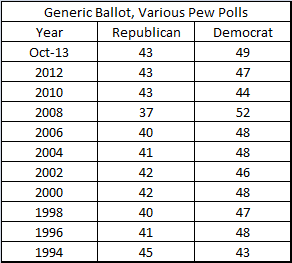
Republicans are down six, which isn’t as strong as their final
showings in 2012 or 2010. Their current number is also not as bad as
their showing in 2006, and nowhere near as poor as in 2008; it’s more on
par with 1996, 1998, 2000, and 2004, when Republicans held the House.
Finally, consider this trend line for favorables and unfavorables for the parties, and for President Obama:
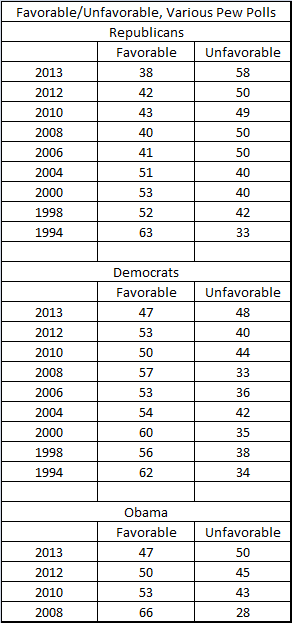
I won’t go through all of the details, but no one looks particularly
strong. The Democrats’ favorability edge over Republicans was 11 points
in 2012, 12 points in 2006, and 17 points in 2008. Today, its nine,
which is somewhere between the 2012 edge and the Democrats’ seven point
edge in 2010.
Finally consider PPP’s Senate race polling, which
was teased as evidence of a strengthening Democratic playing field.
Here’s where PPP finds the Democratic edge in varying states today, and
in its last polling:
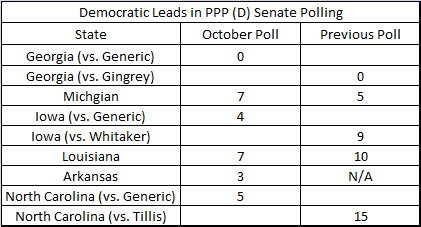
There’s a little bit of an apples-to-oranges problem here, because
PPP polled “generic Republican” so many times in this last iteration,
but even then, we don’t see massive movement against Republicans. In
fact, the two apples-to-apples comparisons we have, Michigan and
Louisiana, show a two-point movement toward the Democrat and a
three-point movement toward the Republican, respectively.
This isn’t to say that everything is great for Republicans. In particular, I credit Stu Rothenberg’s observations
that the divides in the party could trigger recriminations in
primaries, hurting the GOP’s chances. The Republican base may become
demoralized, preventing the traditional GOP edge in off-year elections
from materializing. And we might see Democrats’ fortunes grow now that
the shutdown has been resolved in their favor (we probably will, in
fact, at least in the short term).
But for now, there’s really not much evidence that Republicans took it on the chin, at least electorally speaking.
No comments:
Post a Comment